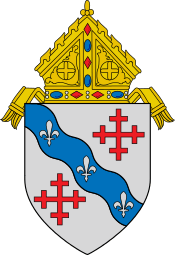Saint Ludmila's Church (Cedar Rapids, Iowa)

Saint Ludmila's Church is a Catholic parish in Cedar Rapids, Iowa. The parish is part of the Archdiocese of Dubuque. The parish is noted for the Kolach Festival, which takes place yearly in June.
Early history
In 1906, Father Florian Svrdlik of St. Wenceslaus Church, and John Viktor purchased five acres (20,000 m²) of land in southwest Cedar Rapids. They did this to establish a Bohemian home for the aged, as well as a school. The school was opened in 1914. A new parish, dedicated to St. Ludmila was founded in 1915, and was initially based in the school chapel. Until November 1922 St. Ludmila's was a mission of nearby St. Wenceslaus parish.
On October 6, 1922, Rev. Francis Hruby was named the first pastor of the parish. He would hold this position until his death in the early 1960s. He directed the building of a new church in 1926. A pipe organ was installed in the church in 1929, and stained glass windows were added in 1932.
The New Church Building
From 1926 until 2000, the original church building served the needs of the parish quite well. But by the 1990s, it was becoming clear that the old building was in need of major repairs and renovation. Also, the Archdiocese wanted to lower the number of weekend masses from four down to three because of the priest shortage. They also wanted to account for the increasing population in the Cedar Rapids area.
In 1995, the Parish Council commissioned an ad hoc committee to study the future of the parish. They looked at several alternatives, including repair and expansion of the original building, or replacement of the original building. It soon became apparent that it would be better to replace the building than to attempt to renovate the building. In 1999, the parish formally declared that it would build a new church. The parish financed $1.2 million towards the construction of the new church, and the Archdiocese financed the remaining $3 million.
During June 2000, the parish was moved into temporary quarters in the school cafeteria. Items meant to be used in the new building, included the tabernacle, the organ, and the stained glass were carefully removed from the building and preserved. In July 2000, the old parish church was finally taken down to make way for the new church.
Over the next year, the new church building was built just east of the old building. Unlike the old building, the structure was made up largely of steel and concrete. By September 2001, the building was finally ready for use. On September 1, 2001, Archbishop Jerome Hanus participated in the dedication ceremony at the church.
The new building is a two-story facility. The main church occupies the top floor of the building. In the main worship space, the congregation is situated in a semicircle around the altar. There are two large glass walls along the sides of the church - this was conceived as a way of making the mass more open to nature. The tabernacle is located in a separate Blessed Sacrament chapel. This small chapel also has an exterior entrance of its own to accommodate exposition and benediction. Behind the main worship area, there is a large gathering space. There is also an elevator to the lower floor, as well as a large staircase. On the lower floor of the building, there is a large meeting room suitable for parish meetings, parties, funeral dinners, and other parish functions.
The pipe organ from the old building was rebuilt in the new parish. Also, the stained glass windows were placed along the glass walls. While the stained glass windows could originally be opened in the old building, this is no longer the case as the building is totally climate controlled.
